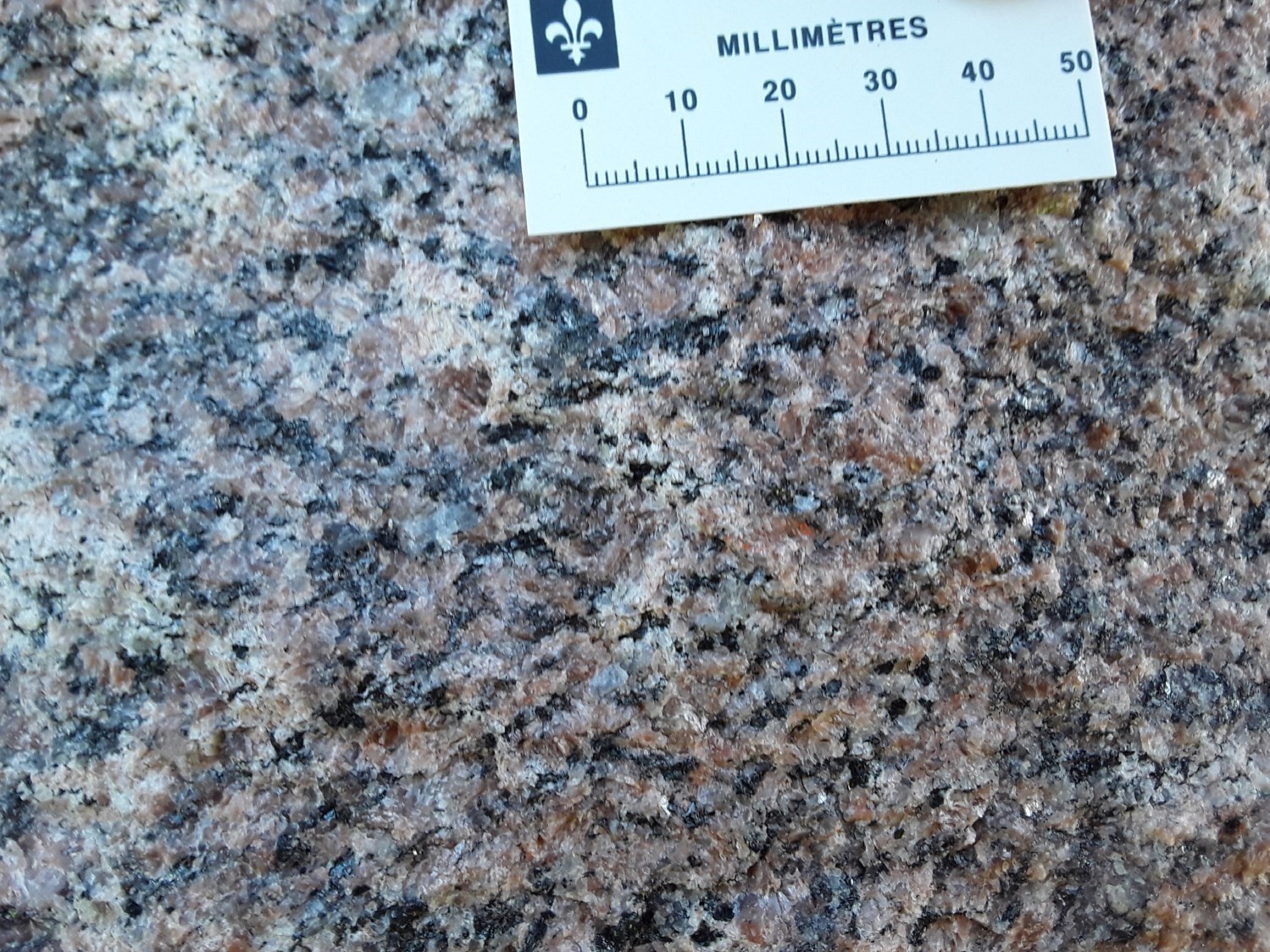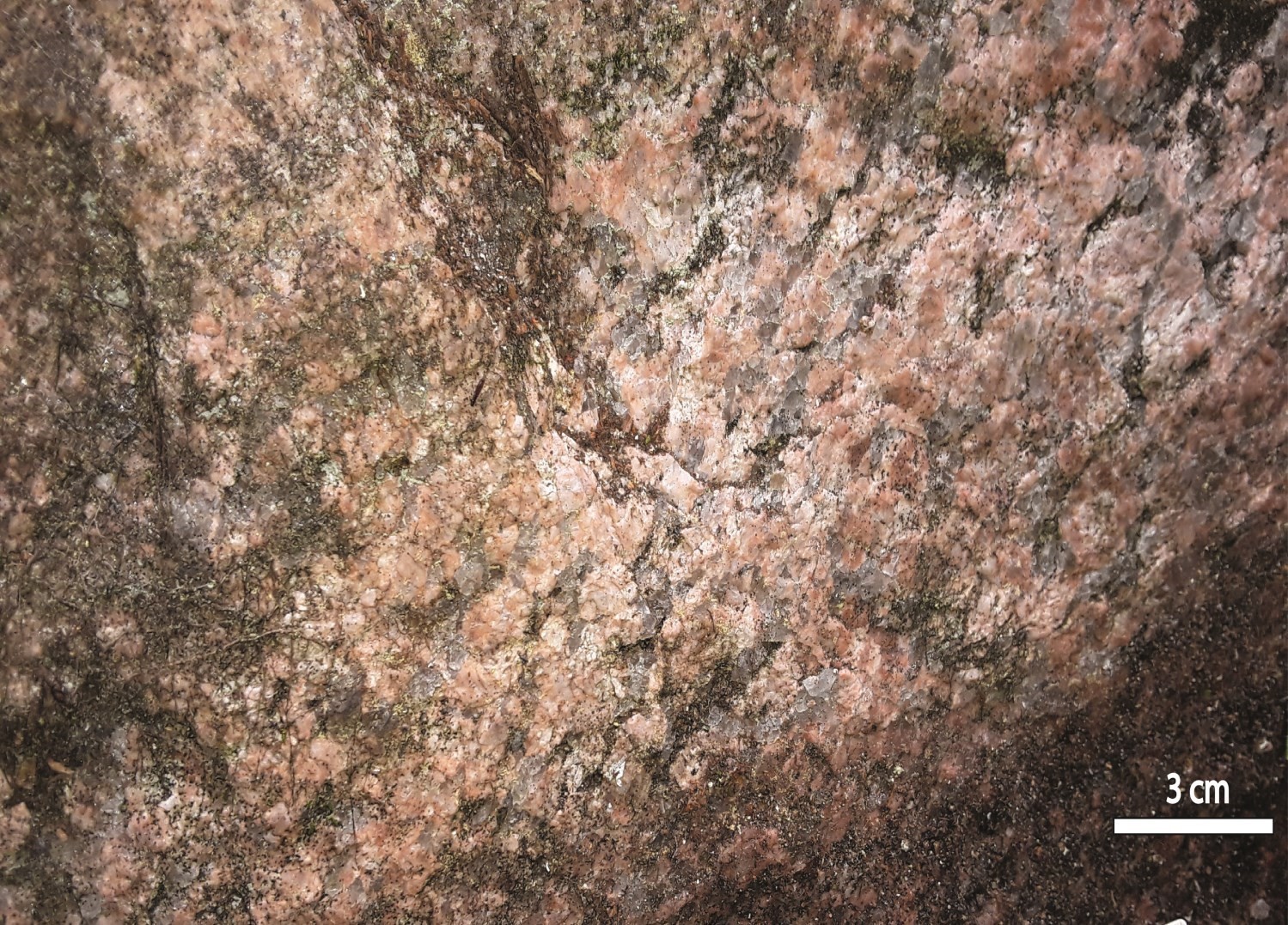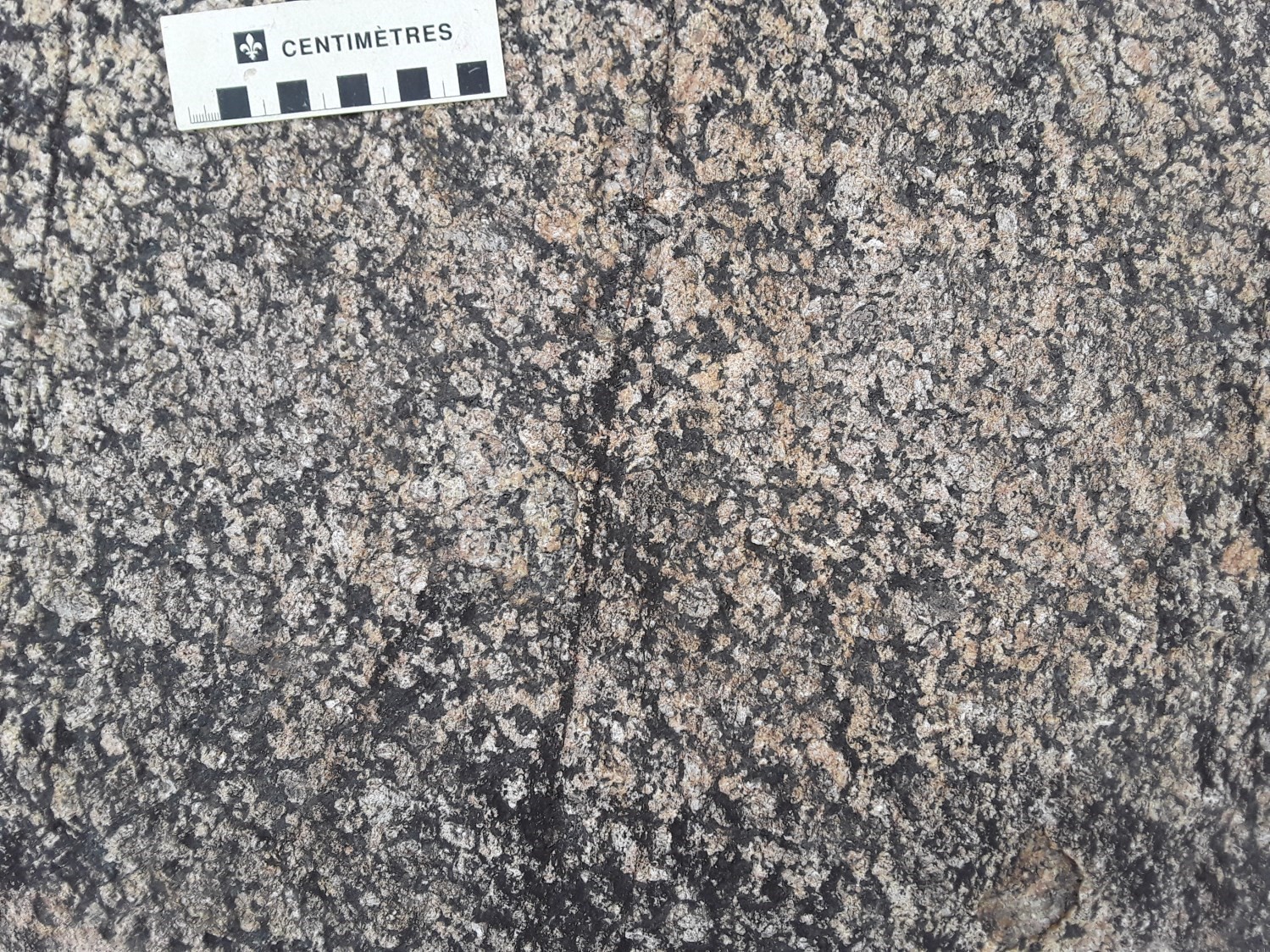
DISCLAIMER: This English version is translated from the original French. In case of any discrepancy, the French version shall prevail.
| Author: | Moukhsil and El Bourki, 2020 |
| Age: | Mesoproterozoic |
| Stratotype: | Typical locality near the town of Normandin; reference outcrop 19-AM-42 (located 3.5 km NE of the town of Normandin, on the side of road 169) |
| Type area: | Town of Normandin area (NTS sheet 32A15) |
| Geological province: | Grenville Province |
| Geological subdivision: | Allochton |
| Lithology: | Felsic, intermediate and mafic plutonic rocks |
| Category: | Lithodemic |
| Rank: | Suite |
| Status: | Formal |
| Use: | Active |
None
Background
The Saint-Méthode Plutonic Suite was defined by Moukhsil and El Bourki (2020) during mapping work in the Normandin-Roberval-Saint-Félicien area of the Saguenay-Lac-Saint-Jean region (sheets 32A09, 32A10, 32A15 and 32A16). Previously, Morfin et al. (2015) had not individualized this suite on their geological map of sheets 32A09 and 32A10, although it is very magnetic and easily identifiable on aeromagnetic maps (Intissar and Benahmed, 2015).
Description
The Saint-Méthode Plutonic Suite corresponds to a large polyphase batholith consisting mainly of alkali feldspar granite, mangerite and quartz syenite. It also includes minor amounts of gabbronorite, hypersthene syenite and paragneiss enclaves of the Barrois Complex.
Alkali feldspar granite is foliated and salmon-pink in fresh and altered surfaces. It is medium to coarse grained and is composed of microcline, large zones of quartz with undulatory extinction, locally chloritized biotite, titanite, and lesser amounts of orthopyroxene and accessory minerals (zircon, epidote, apatite). Some outcrops of this facies are K-feldspar porphyritic (phenocrystals 1-2 cm thick). In thin section, alkali feldspar granite locally contains millimetric myrmekite grains, titanite with opaque mineral cores (magnetite), sericitized plagioclase crystals and some perthitic K-feldspar. In general, the granite’s texture is magmatic; however, at the edge of the intrusion, granite is deformed and exhibits crumbled and stretched quartz grains.
Mangerite is whitish to greyish in altered patina and pinkish to greenish in fresh exposure. It is composed of quartz forming large quartz zones with undulatory extinction, in places myrmekitic, sericitized plagioclase, K-feldspar having a mesh texture (microcline), ferromagnesian minerals (orthopyroxene, clinopyroxene, green hornblende and biotite) whose arrangement in elongated clusters marks foliation, opaque minerals (magnetite and pyrrhotite), and accessory minerals such as apatite, zircon and titanite. It is mainly K-feldspar porphyritic, and although its texture is generally magmatic, several outcrops display significant deformation at faults and shear zones.
Quartz syenite is greyish or salmon-pink in fresh and altered surfaces (outcrop 19-CD-10100), and coarse grained. It is K-fledspar porphyritic. It is perthitic and displays Carlsbad twinning locally. It is also composed of quartz forming large zones with undulatory extinction, locally myrmekitic, and smaller amounts of plagioclase (sericitized), ferromagnesian minerals (green hornblende and biotite), opaque minerals (magnetite), and accessory minerals such as apatite and zircon. Quartz syenite contains centimetric enclaves of fine-grained gabbronorite. Hypersthene syenite has the same composition as quartz syenite, but contains 5-8% orthopyroxene. In the field, a few outcrops of syenite display a coronitic texture with hypersthene in the centre and clinopyroxene at the edge, the latter being in turn lined with magnetite.
Gabbronorite outcrops at several points of the intrusion. It is black in fresh exposure and rusty black in altered patina. The rock is fine-grained, locally plagioclase porphyritic and foliated. It is composed of orthopyroxene, clinopyroxene, amphibole, plagioclase, biotite and magnetite. Gabbronorite also contains K-feldspar xenocrystals from the syenite of the same unit; outcrop 19-DJ-8136 displays magmatic mixture and diffuse contact between the two facies. This also indicates that these facies are probably cogenetic. In places, injections of the syenitic facies into gabbronorite are also observed.
Thickness and Distribution
The Saint-Méthode Plutonic Suite consists of a polyphase batholith which is ~32 km long and ~19 km wide (608 km2). It outcrops mainly in sheets 32A09 and 32A10. The interpretation of aeromagnetic maps of the area (Intissar and Benahmed, 2015) has allowed for extending the unit to the north (sheets 32A15 and 32A16).
Datation
The emplacement age of the suite, i.e. 1021 ±15 Ma, obtained on a mangerite sample (outcrop 2019-AM-0170), coincides with the magmatic event of the middle Grenville (1050-1018 Ma; Gower and Krogh, 2002), which corresponds to a thickening of the crust during the Grenvillian collisional period (e.g. Moukhsil et al., 2017).
| Unit | Sample Number | Isotopic System | Mineral | Crystallization Age (Ma) | (+) | (-) | Reference(s) |
| mPstm | 2019-AM-0170A | U-Pb | Zircon | 1021 | 15 | 15 | Papapavlou, 2020 |
Dating
None.
Stratigraphic Relationship(s)
The Saint-Méthode Plutonic Suite is in fault contact with the Sainte-Hedwidge Intrusive Suite, the Saint-Onge Supracrustal Sequence and the Barrois Complex.
Paleontology
Does not apply.
References
Publications Available Through SIGÉOM Examine
INTISSAR, R., BENAHMED, S. 2015. LEVE MAGNETIQUE AEROPORTE DANS LE SECTEUR OUEST DU LAC-ST-JEAN, PROVINCE DE GRENVILLE. MERN, GOLDAK AIRBORNE SURVEYS. DP 2015-06, 7 pages et 2 plans.
MORFIN, S., TREMBLAY, C., SOLGADI, F., MOUKHSIL, A., DAIGNEAULT, R. 2015. GEOLOGIE DE LA REGION DE CHAMBORD, ROBERVAL ET NOTRE-DAME-DE-LA-DORE (FEUILLETS SNRC 32A08, A09 ET A10) ET RECONNAISSANCE DES FEUILLETS 32A06, A07 ET A11. MERN, CERM. MB 2015-07, 69 pages et 5 plans.
MOUKHSIL, A., EL BOURKI, M. 2020. Géologie de la région de Normandin, Province de Grenville, région du Saguenay – Lac-Saint-Jean, Québec, Canada. MERN. BG 2020-01, 1 plan.
MOUKHSIL, A., SOLGADI, F., JANNIN, S., GERVAIS, F., CROWLEY, J L., AUGLAND, L E., INDARES, A., LETOURNEAU, M., DUNNING, G., CLARK, T., GOBEIL, A., OHNENSTETTER, D., LAMOTHE, D., INTISSAR, R., BENAHMED, S., GROULIER, P A., 2017. GEOLOGIE, POTENTIEL MINERAL ET CADRE GEODYNAMIQUE DES ROCHES DE LA REGION DU RESERVOIR DANIEL-JOHNSON (MANICOUAGAN), PARTIE CENTRALE DE LA PROVINCE DE GRENVILLE. MRN; MM 2017-01, 307 pages, 1 plan.
PAPAPAVLOU, K., 2020. U-Pb geochronology report, Grenville 2019-2020. UQAM; MB 2020-09, 25 pages.
Other publications
GOWER, C.F., KROGH, T.E. 2002. A U-Pb geochronological review of the Proterozoic history of the eastern Grenville Province. Canadian Journal of Earth Sciences, volume 39, pages 795-829. doi.org/10.1139/e01-090
Suggested Citation
Ministère de l’Énergie et des Ressources naturelles (MERN). Saint-Méthode Plutonic Suite. Quebec Stratigraphic Lexicon. https://gq.mines.gouv.qc.ca/lexique-stratigraphique/province-du-superieur/suite-plutonique-de-saint-methode_en [accessed on Day Month Year].
Contributors
|
First publication |
Abdelali Moukhsil, P. Geo., Ph.D. abdelali.moukhsil@mern.gouv.qc.ca; Mhamed El Bourki, GIT, M.Sc.A. mhamed.elbourki@mern.gouv.qc.ca (redaction) Mehdi A. Guemache, P. Geo., Ph.D. (coordination); Fabien Solgadi, P. Geo., Ph.D. (critical review); Simon Auclair, P. Geo., M.Sc. (editing); Céline Dupuis, P. Geo., Ph.D. (English version); Ricardo Escobar Moran (HTML editing). |







